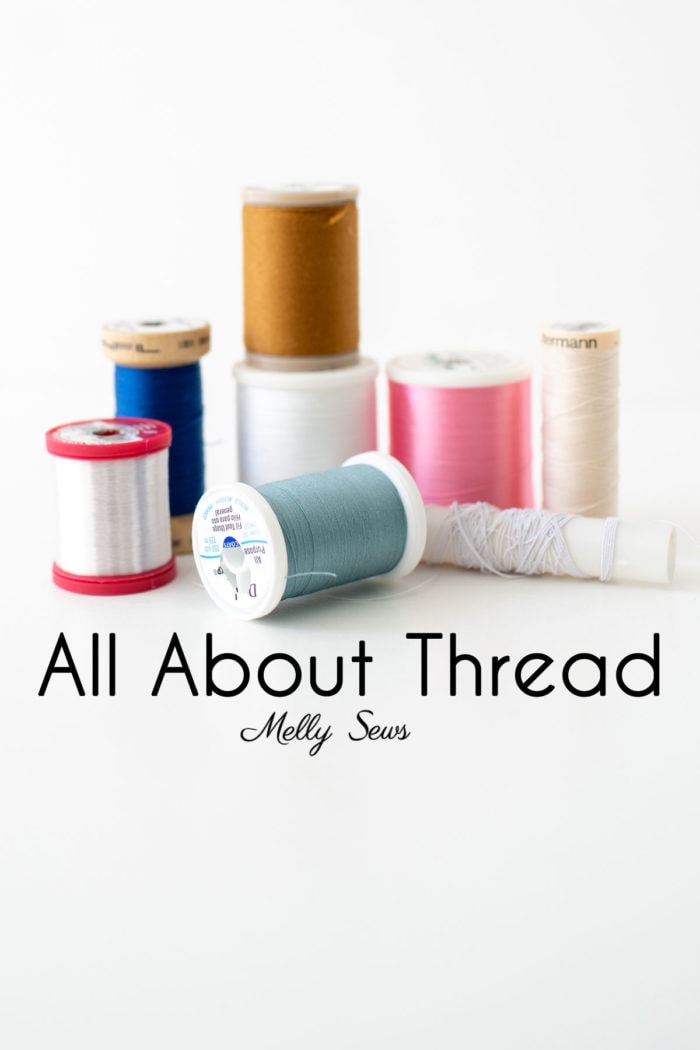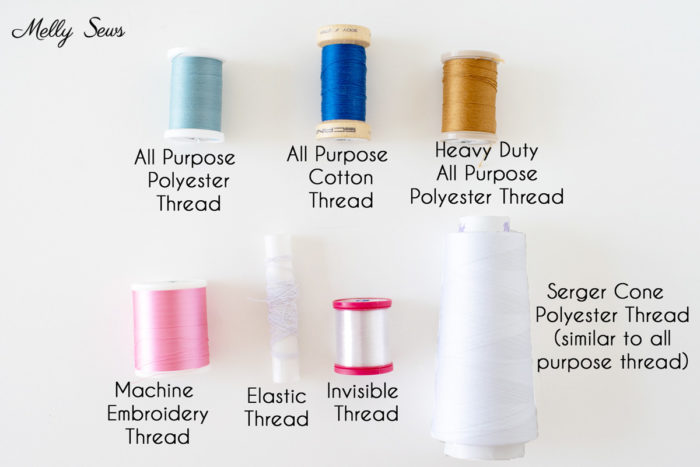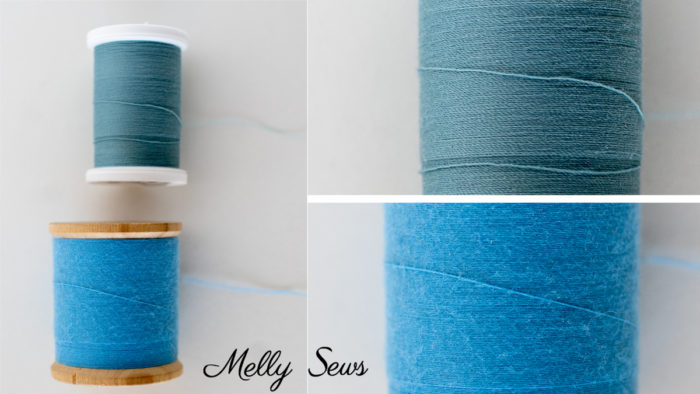Learn what kind of thread to use with your sewing machine for different fabrics and projects

Hey y’all, today we’re going to talk about types of sewing thread. How do you know which type of thread to use? What do thread weights mean? Which is the best brand of thread to use? We’ll talk about all of those questions today.
This is the first post in a series I’m starting to answer your sewing questions. If you have a question you can’t find the answer to you can submit it here for future consideration. Remember that there’s a search bar in the top menu of this site, so try that first – there’s a good chance I’ve already answered your question, and then you won’t have to wait and wonder if it will be the subject of a future post.
Sewing Threads
Sewing threads are described by fiber, weight and use. Fibers like cotton, polyester and nylon are spun into threads (cotton) or stretched into filaments (nylon). The fiber and weight of the thread affects what kind of stitches that thread makes. Those properties also translate into differences in durability and appropriate uses for each thread.
To further illustrate the discussion of kinds of thread, I’ve got a video below, which you can also watch on YouTube here.
A summary of the information in the video is below, starting with this image of different types of thread. In general, if you’re wondering what type of thread to use, reach for all purpose polyester thread. If you want a more sustainable sewing option, choose all purpose cotton.

Types of Sewing Thread
- All purpose thread. Made of polyester, cotton, or a combination of the two, this medium weight thread is suitable for most sewing projects in fabrics ranging from light to medium-heavy weights. Mercerized cotton all purpose thread will have more of a sheen to it than plain cotton thread.
- Heavy duty all purpose thread. Use this for heavy weight fabrics – like upholstery fabric. I also like to use it as a topstitching thread on things like jeans
- Machine embroidery thread – made of viscose or rayon, machine embroidery thread is thinner and lighter weight and is used for machine embroidery. It also often has more of a sheen than all purpose thread.
- Elastic thread – used for shirring
- Invisible thread – like thin fishing line. This is a monofilament thread for sewing sequins and specialty uses, not general use.
- Serger cone thread – this lightweight thread is similar to all purpose polyester, but thinner
How to Choose Thread
- Match your thread type to your project type. General sewing projects work well with all purpose thread, from garments to home decor, even basic quilting.
- Match your thread type to your fabric – thinner fabrics might need fine weight all purpose thread, very heavy fabrics need heavy duty all purpose thread. If you’re sewing a delicate fabric like a fine silk charmeuse, it might be worthwhile to get fine silk thread. If you’re topstitching denim and you want more seam strength, use a heavier weight thread. Hand sewing leather would take an even heavier thread.
- Match your thread type and needle. There’s no point in using a fine weight thread with a large needle; if your fabric needs fine weight thread it also needs a smaller needle. So fine weight thread with a 70/10 needle, heavy weight thread with a 100/16 or larger needle. Mismatching your needle and thread is a good way to frustrate yourself with thread breakage.
- When in doubt, I use all purpose thread and an 80/12 needle and sew a scrap piece of the fabric to test.
- Remember that you may need to adjust your machine tension when switching to thicker or thinner threads.
- Brands I tend to use over and over are Coats and Clark and Gutermann for all purpose and heavier threads, and Sulky for machine embroidery threads.
What is Thread Weight?
Thread weight is the number of lengths of thread make up a certain weight of thread. So a higher number indicates thinner thread because more lengths of thinner thread are needed to achieve the same weight. General all purpose thread is about 50 wt, fine weight thread is 60-70 wt, and heavy duty thread is usually 30-40 wt. Thread eights are not precise measurements. You might also see references to the tex of a thread, which is a precise measurement. Tex weighs 1000 meters of thread, so higher tex numbers are heavier threads (which is the opposite of how thread weight is usually described). A tex 25 thread would mean 1000 meters weighed 25 grams.
Machine embroidery thread can also be described by denier, which is the weight in grams of 9000 meters of thread. This standard tries to describe the thickness of threads to help embroiderers determine how a thread will work with a dense embroidery design.
Note that fiber can affect the weight of a thread in all measuring systems, as cotton and polyester and other fibers don’t weigh the same amount. You can really get down in the weeds with thread weights, so for purposes of home garment sewing I just generally stick to 40-50 wt or tex 30 (all purpose) to tex 80 (heavyweight topstitching) weights. Serger thread is often 30ish weight or tex 27.
Does Thread Expire?
Yes! Thread has a shelf life, though it’s hard to say exactly what that shelf life is. This question most often comes up because someone has inherited sewing supplies, including vintage thread. My advice for vintage thread – if it’s pretty and you want to use it as decor, keep it, if not, throw it away.
Below I have an image of vintage all purpose thread that I was given and use as decor because I like the wood spool. Note how much fuzzier the vintage thread is than my recently purchased thread. That fuzz becomes lint and will gum up your machine. In addition, I can easily pull on the vintage thread and break it because it’s lost elasticity or the ability to withstand high tension, also referred to as tensile strength. So if I used it to sew myself something, I’d be setting myself up for my seams to tear, pop or rip.

I hope that helps answer your questions when it comes to how to choose the right thread for your sewing project.

Dianne Underwood
Thank you for this informative post. It has helped clarify what thread is best to use and when. I particularly liked that you included the general weights with the threads as often I see some on sale and wonder if they would be the right size for what I am doing.
Judy Griesel
Thank you for your information about thread expiring. Using thread that must have been an older thread, made my sewing machine make odd sounds and operate in a different manner. This thread, I did not put a date on it. Your information explained why there was a problem. I made a habit of putting a date on the thread label, so I would use that thread first. Now dating the thread has an additional meaning. I also knit, and yarn does age and becomes weak and break when it is older.
Marjolijn Walsh
Great explanation, thanks. Ive been sewing for years but still didn’t know much about thread
Paula
Thank you very much, Melly. Thanks to you I now know how to wind my threads back on the spool without it unraveling. 🙄 Very informative!
Carmella
Very informative. This explains some of the problems I have with certain threads. Into the trash they go, buying some new thread as soon as the stores open again!
Joanna
Very useful post and video. Thank you for breaking down the seemingly simple stuff. I had NO IDEA how to wind and store the thread ends. Delightful!
Mea Cadwell
Good article and great picture showing the difference between vintage thread and new thread. But don’t throw out that vintae thread, it’s great for hand basting so it isn’t wasted.